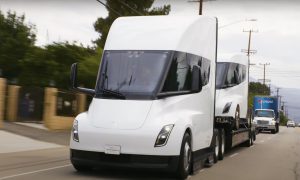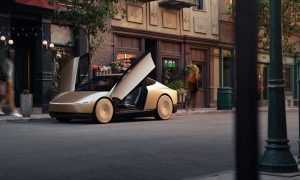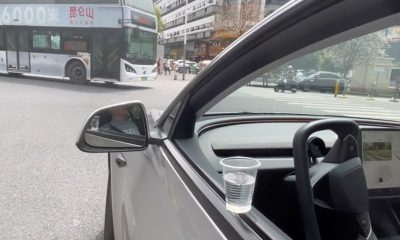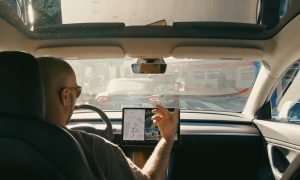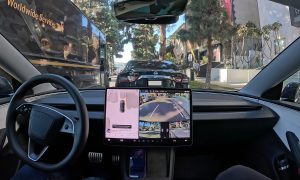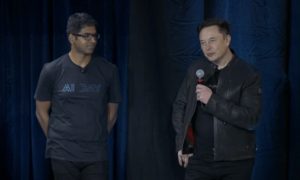News
Self-driving Teslas and autonomous vehicles will end traffic as we know it
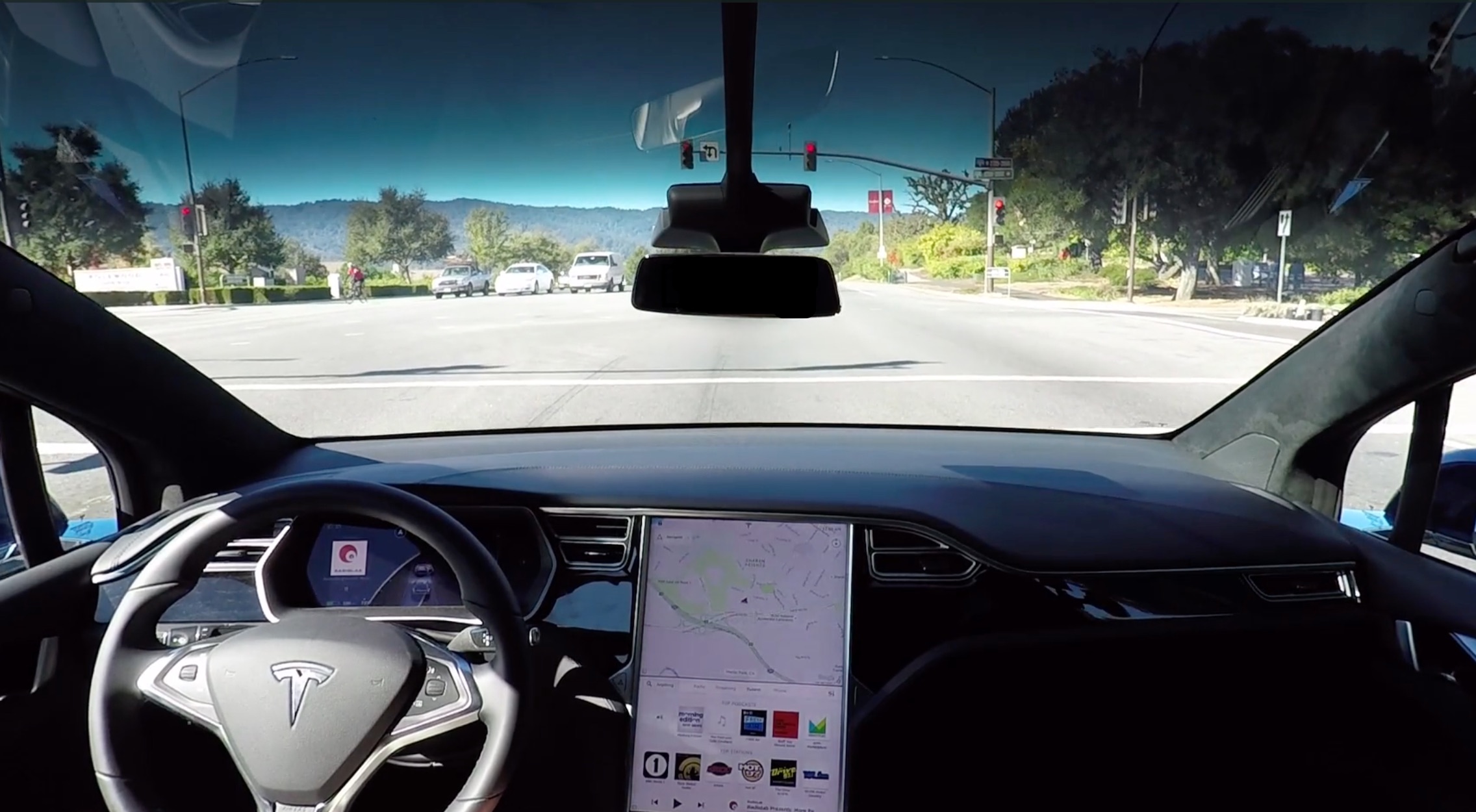
We are all fascinated with autonomous driving in terms of what it can do for us. Make the elderly mobile again without endangering the rest of us with their arguably reduced reaction times, less acute hearing and vision. We dream of the day when we can sleep through a long, boring trip. Doing valuable work in what would otherwise be dead time is a plus too. One thing we haven’t talked about too much is how autonomous cars can radically reduce the congestion of our roads.
Six Inches of Separation (With All Due Respect to Kevin Bacon)
One way we can reduce highway congestion is to reduce the following distances between cars. It takes a human about four seconds to react to a car stopping ahead of us. At 60 mph, that translates to 88 feet per second or a total traveled of 352 feet before you are really starting to stop the car. Using the 2 1/2 second rule would yield 220 feet. Now if you have a car which reacts in, oh say, 1,000 nanoseconds, or a millionth of a second, some have argued that a six inch separation would be more than enough time for the computer to stop the car in time to avoid a collision. So, a non-autonomous car would take up about 220 feet of roadway per car, autonomous cars would take up roughly 20 feet per car. 220 divided by 20 yields about 11 cars per 220 feet of roadway rather than one. You’ve magically increased the carrying capacity which decreases congestion.
Platooning
This increased use of autonomy will almost certainly create “platooning” on our roads where cars headed in the same direction are pulled up within inches of the car ahead creating a “car train” of 30, 50, or more cars all traveling at high speed to a destination ahead of them. With level 5 autonomy, some have suggested that 90 mph is reasonable while remaining very safe.
So let’s do a mind experiment here. You have a 220 foot stretch of roadway which can now safely carry 1 car traveling at 60 mph. Let’s put in a platoon of 11 cars traveling at 90 mph. That 220 foot stretch of roadway at 90 mph can carry 15 cars rather than 11 because 90 is 150% of 60. You have now increased the carrying capacity of the roadway by 1500%, or put another way, it would be like the New York State Thruway had 1/15 the cars on it that it does now. Rush hour would be like driving at three in the morning.
You may say that 220 feet is a preposterous amount of road and that people routinely travel only 10 to 20 feet behind the car in front of them. My response is look at the accident statistics. Yeah, you can travel that close. You just can’t travel that close safely.
Goose it Man!
One of the arguments against high speed travel in cars has been that as you increase speed, miles per kilowatt drop radically. Wind resistance is the big thief of range. When you read about people who manage to get ridiculous miles per charge out of their Teslas you can bet that last dollar that they are driving slowly!
Here’s where we can take a lesson from NASCAR and…wait for it, GEESE! Any fan of NASCAR knows that the drivers “draft” the car in front of them to save gas. The reason is very simple. The car in front is pushing the air out of the way, and the car behind benefits from traveling at the same speed in a partial vacuum, enabling the following driver to save fuel and possibly avoid a pit stop.
Why am I talking about geese? Ever wonder why geese travel in that cool V-formation? Similar reason. They avoid the turbulence from the goose ahead and conserve energy. Being cooperative sorts they trade places with the leader, who drops back and lets the next goose in line take over the toughest place, which is the lead. That way all the geese get to where they’re going quicker and with less fatigue. In our terms, with less battery energy expended.
I foresee platooning supplemented with leader “dropback” like the geese, let’s say, every five miles, to enable very fast driving times with lower fuel/kilowatt hour consumption. This will become part of the autonomous software suite.
So, all hail the goose, and I, for one, look forward to autonomous driving because of the effect platooning will have on our drives, and the automatic increase of the carrying capacity of our roads. Cool, very cool!
Allan Honeyman
(Submitted via email to the Teslarati Network. Do you a post you’d like to share? Email it to us at info@teslarati.com)
News
SpaceX’s Crew-11 mission targets July 31 launch amid tight ISS schedule
The flight will lift off from Launch Complex 39A at Kennedy Space Center in Florida.

NASA and SpaceX are targeting July 31 for the launch of Crew-11, the next crewed mission to the International Space Station (ISS). The flight will lift off from Launch Complex 39A at Kennedy Space Center in Florida, using the Crew Dragon Endeavour and a Falcon 9 booster.
Crew Dragon Endeavour returns
Crew-11 will be the sixth flight for Endeavour, making it SpaceX’s most experienced crew vehicle to date. According to SpaceX’s director of Dragon mission management, Sarah Walker, Endeavour has already carried 18 astronauts representing eight countries since its first mission with NASA’s Bob Behnken and Doug Hurley in 2020, as noted in an MSN report.
“This Dragon spacecraft has successfully flown 18 crew members representing eight countries to space already, starting with (NASA astronauts) Bob (Behnken) and Doug (Hurley) in 2020, when it returned human spaceflight capabilities to the United States for the first time since the shuttle retired in July of 2011,” Walker said.
For this mission, Endeavour will debut SpaceX’s upgraded drogue 3.1 parachutes, designed to further enhance reentry safety. The parachutes are part of SpaceX’s ongoing improvements to its human-rated spacecraft, and Crew-11 will serve as their first operational test.
The Falcon 9 booster supporting this launch is core B1094, which has launched in two previous Starlink missions, as well as the private Ax-4 mission on June 25, as noted in a Space.com report.
The four-members of Crew-11 are NASA astronauts Zena Cardman and Mike Fincke, as well as Japan’s Kimiya Yui and Russia’s Oleg Platonov.
Tight launch timing
Crew-11 is slated to arrive at the ISS just as NASA coordinates a sequence of missions, including the departure of Crew-10 and the arrival of SpaceX’s CRS-33 mission. NASA’s Bill Spetch emphasized the need for careful planning amid limited launch resources, noting the importance of maintaining station altitude and resupply cadence.
“Providing multiple methods for us to maintain the station altitude is critically important as we continue to operate and get the most use out of our limited launch resources that we do have. We’re really looking forward to demonstrating that capability with (CRS-33) showing up after we get through the Crew-11 and Crew-10 handover,” Spetch stated.
Lifestyle
EV fans urge Tesla to acquire Unplugged Performance for edge in fleet and security industry
Unplugged Performance has built a name for itself by producing performance upgrades for Tesla vehicles.

A growing number of Tesla enthusiasts and longtime community voices are calling on the electric vehicle maker to acquire Unplugged Performance, a California-based aftermarket company best known for tuning Tesla vehicles and developing specialized government fleet solutions under its UP.FIT division.
The idea was once considered a niche proposal among EV fans, but it is now gaining serious attention not just as a performance play but as a strategic move to deepen Tesla’s roots in the fleet and security industry.
A strategic fit
Unplugged Performance has built a name for itself by producing performance upgrades for Tesla vehicles, from track-optimized components to visual and aerodynamic upgrades. But in recent years, its UP.FIT division has pivoted toward a more functional future by outfitting Tesla vehicles like Model Ys for police, military, and government use.
That work has sparked growing calls for closer collaboration with Tesla, especially as the EV maker increasingly leans into autonomy, AI, and fleet services as core components of its next chapter.
“I posted this four years ago, but I think it’s more true now than ever,” wrote Whole Mars Catalog, a well-known Tesla investor and FSD Beta tester, on X. “Tesla should buy Unplugged. But not just as a Performance division. What they are doing with UP.FIT unlocks large government and commercial fleet purchases that can improve utilization.”
Tesla fans such as shareholder Sawyer Merritt echoed the sentiment, calling Unplugged a “great fit within Tesla.” adding, “They are literally located directly next to Tesla’s design studio in Hawthorne.”
Enabling the next wave
Supporters of the idea noted that integrating Unplugged into Tesla’s corporate structure could help accelerate the adoption of autonomous technologies in government sectors. With UP.FIT patrol cars already in use across some U.S. police departments, Tesla fans envisioned a future where self-driving Teslas could potentially revolutionize law enforcement, search-and-rescue, and public service logistics.
“Just imagine how autonomous patrol cars could transform policing and bring us into a safer future,” the veteran FSD tester wrote.
The benefits could also extend to Tesla’s existing consumer base. “They also have some incredible products in the works that I think will appeal to many ordinary Tesla drivers — not just those looking for performance or mods. Stuff that’s so good it should have come straight from the design studio next door,” Whole Mars Catalog noted.
Unplugged Performance, founded in 2013, shares not just a product vision with Tesla, but also geography. Its Hawthorne headquarters sits directly adjacent to Tesla’s design studio, and the two companies have maintained a close working relationship over the years. The aftermarket firm has long positioned itself as a “mission-aligned” partner to Tesla.
In response to the recent calls for acquisition, Unplugged Performance acknowledged the support from the community. “Our very existence is to support the Tesla mission with @UpfitTesla and @UnpluggedTesla,” Unplugged CEO Ben Schaffer posted on X. “We love working with Tesla and are grateful for the community’s support since 2013!”
News
Tesla debuts hands-free Grok AI with update 2025.26: What you need to know
All new Tesla vehicles delivered on or after July 12, 2025, will include Grok AI out of the box

Tesla has begun rolling out Grok, an in-car conversational AI assistant developed by xAI, to eligible vehicles starting July 12. The feature marks the most direct integration yet between Elon Musk’s artificial intelligence startup and Tesla’s consumer product lineup, offering drivers hands-free access to a chat-style companion while on the road.
Grok comes pre-installed on new vehicles
According to Tesla’s FAQ page for the feature, all new vehicles delivered on or after July 12, 2025, will include Grok AI out of the box. Owners of older vehicles may gain access through an over-the-air update, provided their vehicle meets a few hardware and software requirements.
Specifically, Grok is currently only supported on Tesla models equipped with an AMD infotainment processor and running vehicle software version 2025.26 and higher. Compatible models include the Model S, Model 3, Model X, Model Y, and Cybertruck. A Premium Connectivity subscription or active Wi-Fi connection is also required.
Tesla notes that additional vehicle compatibility may arrive in future software updates.
Grok’s features and limitations for now
Drivers can engage with Grok using the App Launcher or by pressing and holding the voice command button on the steering wheel. Grok is designed to answer questions and hold conversations using natural language, offering responses tailored to its chosen personality—ranging from “Storyteller” to the more eccentric “Unhinged.”
For fun, Tesla posted a demonstration of Grok likely running on “Unhinged” talking about what it would do to Optimus when they are on a date, much to the shock of the humanoid robot’s official social media account.
It should be noted, however, that Grok cannot currently issue commands to the vehicle itself, at least for now. Traditional voice commands for tasks like climate control, navigation, or media remain separate from Grok as of writing.
The feature is being released in Beta and does not require a Grok account or xAI subscription to activate, although that policy may change over time.
Grok privacy and in-car experience
Tesla emphasizes that interactions with Grok are securely processed by xAI and not linked to a user’s Tesla account or vehicle. Conversations remain anonymous unless a user signs into Grok separately to sync their history across devices.
Tesla has also begun promoting Grok directly on its official vehicle webpages, showcasing the feature as part of its in-car experience, further highlighting the company’s increasing focus on AI and infotainment features on its all-electric vehicles.
-

 Elon Musk2 weeks ago
Elon Musk2 weeks agoTesla investors will be shocked by Jim Cramer’s latest assessment
-

 Elon Musk3 days ago
Elon Musk3 days agoxAI launches Grok 4 with new $300/month SuperGrok Heavy subscription
-

 Elon Musk5 days ago
Elon Musk5 days agoElon Musk confirms Grok 4 launch on July 9 with livestream event
-

 News1 week ago
News1 week agoTesla Model 3 ranks as the safest new car in Europe for 2025, per Euro NCAP tests
-

 Elon Musk1 week ago
Elon Musk1 week agoxAI’s Memphis data center receives air permit despite community criticism
-

 News2 weeks ago
News2 weeks agoXiaomi CEO congratulates Tesla on first FSD delivery: “We have to continue learning!”
-

 Elon Musk2 weeks ago
Elon Musk2 weeks agoTesla scrambles after Musk sidekick exit, CEO takes over sales
-

 News2 weeks ago
News2 weeks agoTesla sees explosive sales growth in UK, Spain, and Netherlands in June


